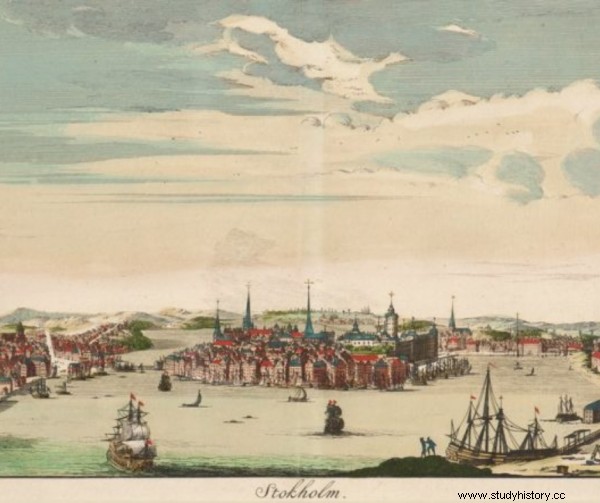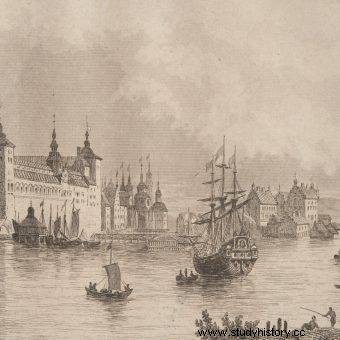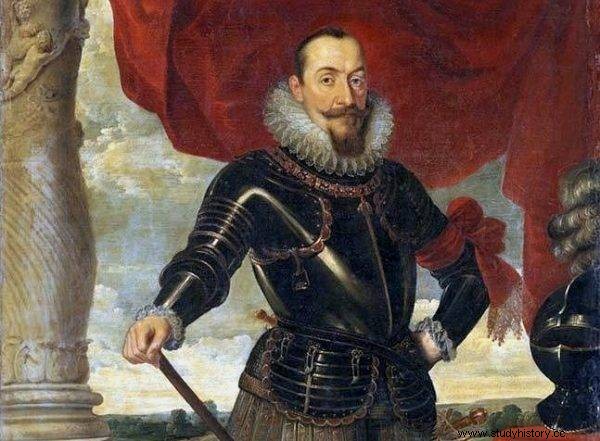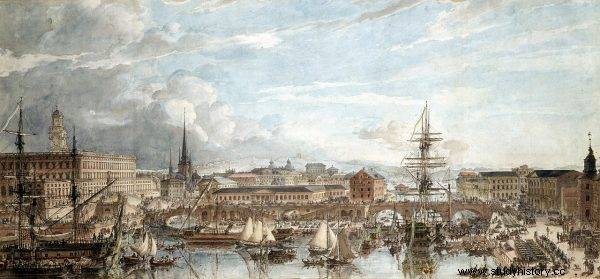Samuel Łaski was a type of man for special tasks. Zygmunt III Waza often sent him to Sweden, the crown of which he wanted to regain. The envoy also participated in the expedition of 1598 - and at the head of eleven men he conquered the capital itself. How did he do it and why was such a victory wasted?
On the night of August 30–31, 1598, a storm raged in Stockholm. Thick raindrops pounded on roofs and windows, and thundered from time to time. On that lousy night, the locals, locked in houses and taverns, drank mulled wine or slept soundly. If, however, one of them dared to go out into the street, they would meet twelve Poles. They were soaked, tired, battered…
Their ship fell into the storm. Despite the broken mast, they somehow won against the element. They made it to land! In fact, this was where the successes ended. They got lost. After all, they were sailing in the royal squadron, consisting of several dozen units, and there was no trace of them. Nothing left of the ship, it crashed to the shore.
"How's what? We are taking the city! ”
Twelve survived, but found themselves in the midst of a hostile country, where even nature showed dissatisfaction with their arrival, welcoming them with a terrible storm. You can imagine what it looked like. They alternately thank God for the saved lives and curse that they are in a little better situation than those who were swallowed up by the Baltic Sea. They can see a lantern in the distance.
- I know where we are! Samuel Grace exclaims happily. - It's Stockholm!
- What are we doing? - another of the survivors asks.
- What is what? We are taking the city!
Taking twelve people to Stockholm with a population of over 8,000 sounds like an idea born in a drunken head. Although on board ships in the 16th century, alcohol was drunk instead of water, Poles spent their last hours fighting for life at sea, and they were absolutely sober.
Captain Samuel Łaski was the most important person among the survivors, so his word for the other eleven was an order. If he ordered them to capture Stockholm in twelve, they had to do so. They entered the city, assisted by thunder and lightning. They headed for the town hall. They were there at four in the morning. 
It was dark. The sun would not rise for an hour and a half. Nobody resisted, and besides, who would risk a fight with twelve armed soldiers at this hour? Samuel Łaski ordered to be sent for Stockholm patricians. Rich townspeople were torn out of their beds and everyone was ordered to appear before the Polish nobleman.
The newcomer seems strangely familiar to them ... - My name is Samuel Łaski - he introduces himself in German. He knows the language very well, and for patricians in Stockholm, German is often the first language. - Some of you may remember me when I visited Stockholm as an envoy of the Polish king Sigismund III ... So that's how they know him!
- On behalf of King Zygmunt I am taking over the city - declares Łaski. Stockholm patricians surrendered without hesitation to the envoy of King Sigismund III and put their people at his disposal. Łaski planted strategic points in the city, especially the castle and the lighthouse. By noon, the whole city was his. He could calmly send a message to his ruler:"I have taken Stockholm self-reunification" (...)
The best advisor
[While in Sweden during the expedition of King Sigismund III Vasa, begun in 1598] Samuel Łaski noticed that time was playing in favor of the regent [Charles IX of Suderman, the opponent of the Polish monarch in the struggle for the Swedish throne]. The people were still hungry, but the harvest was going to be good. He realized that when their bellies were full, they would stop complaining about the authorities - so Sweden had to be invaded as soon as possible.
Graces even knew how. Instead of pushing by sea towards Kalmar, where Prince Charles was heading with his men (officially under the guise of some kind of congress), it was necessary to safely cross the lands of the Commonwealth, through Prussia, Curland and Livonia, join the Finns and take Stockholm together with Stålarm, which in the face of the attitudes of the municipal authorities should be successful without complications. The capital city in the hands of Sigismund III would mean a huge propaganda success and the beginning of the end of Prince Charles - the rest of the country should surrender without resisting .

Poles ended up in Stockholm ... actually by accident. Illustrative illustration.
Łaski believed that he could outsmart the regent of Sweden on a macro scale. So far he has succeeded on a micro scale. Prince Charles locked him under guard, but this did not stop the Pole. First, he led the Swedish spies out of the way by writing a letter to King Sigismund III with false information, aware that the letter would fall into the hands of the regent's people. He later decided it was time to be released. Having freed himself thanks to what he called himself "some stratagems", he appeared in Oliwa at the end of July.
Sigismund III thought, unfortunately, like the Swedish Vasa, not the Polish Jagiellon. Instead of listening to Łaski, he followed the voice of Scandinavian advisers, that is, he headed towards Kalmar. Even if it would go smoothly - the royal fleet set out on August 3, 1598, but the storm caused the entire ship to land on ... Hel. They set off for the second time, this time they managed to reach Kalmar. The fortress surrendered without a fight. However, the bad news came. The Finns, led by Arvid Stålarm, arrived near Stockholm, but were smashed by Charles' supporters and retreated east, leaving their three hundred men in the hands of their enemies. Samuel Łaski must have gone mad with anger, but all was not lost . You just had to move on.
Meanwhile, Sigismund III died at Kalmar for two weeks! Under the influence of Swedish advisers, he entered into talks with representatives of the princes of the Reich, who were trying to negotiate between the Polish king and his uncle. When it was started, not all the soldiers could fit on the ships. The army was divided.
Unfortunate Cruise
The division headed by the Swede Gustaw Brah and the eighteen-year-old Polish nobleman Jan Weyher was to move by land to the north. The king's main force was to sail to the port of Stegeborg, located about halfway between Kalmar and Stockholm. Of course, you could try to go straight to the capital, but you didn't want to distract your strength. That was the official reason, but not the only one. The king also wanted to meet his sister Anna Wazówna, who was just staying in Stegeborg.
While they were on their way, a storm broke out that scattered Sigismund's fleet. On August 27, only twenty-eight ships reached Stegeborg. Then more came, but two weeks later there were still a dozen or so - a thousand soldiers in total. In other words, a fifth of the Polish king's army was lost . Among the lost ships was also the one with Samuel Łaski on board. It seemed that in the depths of the Baltic Sea the life of a diplomat who had figured out how to conquer Sweden had ended.

In order to go to Sweden, Sigismund III had to first obtain the consent of the Seym of the Republic of Poland.
Then in the evening of September 5, 1598, a newcomer from the capital shows up in Stegeborg. - Samuel Łaski sent me - he declares. - Yes, he is alive and he has just won Stockholm. On this occasion, the next day in the chapel in Stegeborg, Te Deum laudamus was solemnly sung . The courtier of Vice-Chancellor Piotr Tylicki, who was present there, wrote in his diary that "ours are in Stockholm".
Samuel Łaski has been doing quite well since the "self-reunification" took over Stockholm. He deprived the offices of all supporters of Prince Charles in the city. He managed to find other survivors from King Sigismund's fleet - first one hundred and fifty Scottish and one hundred German mercenaries, then more. After all, he had five hundred soldiers at his disposal. Unfortunately, far too little to think about staying longer in Stockholm .
The king doesn't come
The messenger of Łaski, who had brought the good news, asked the king to arrive by sea as soon as possible, especially since the winds were favorable. It was also about a propaganda goal, because the people in the city did not believe that Zygmunt was in Sweden. At that time, the facts were that Stockholm was controlled by a foreigner whom the locals associated with having been sent twice on behalf of the Polish king. In addition, the regent spread rumors that there was no Sigismund in Sweden, and that the foreign invaders were led by a self-proclaimed man (...)

Łaski was doing well in Stockholm - but he needed the king's support quickly.
Zygmunt once again disobeyed the wisest of his advisers. He wrote back to Łaski that he was happy to take the city, ordered him to watch over it and prevent it from being taken by Prince Charles. [Unfortunately for Łaski, already on October 6, 1598] in Linköping, the king signed a treaty that was unfavorable for himself. On his order, Sigismund was to send foreign soldiers and go to the Sejm in Stockholm, which was called on January 15, 1599. He kept the first part of the contract, the second he did not - because he fled to Poland unexpectedly.
After the Treaty of Linköping was concluded, three strongholds remained in the hands of Sigismund III:Stockholm, Elfsborg and Kalmar. Samuel Łaski ruled in the capital on October 4, 1598. Presumably he evacuated from Sweden shortly after, in November Stockholm was already under the control of Prince Charles . The regent had easily subjugated Elfsborg. [The crew of Kalmar capitulated on May 12, 1599].
Source:
The above text was originally published as part of the book by Michael Morys-Twarowski Polskie empium , published by the Znak Horyzont publishing house.
The title, lead, illustrations with captions, boldface text, explanations in square brackets and subheadings come from the editors. The text has undergone basic editorial work to introduce more frequent breakdown of paragraphs. For the sake of integrity of the text, the footnotes in the book version have been removed.
